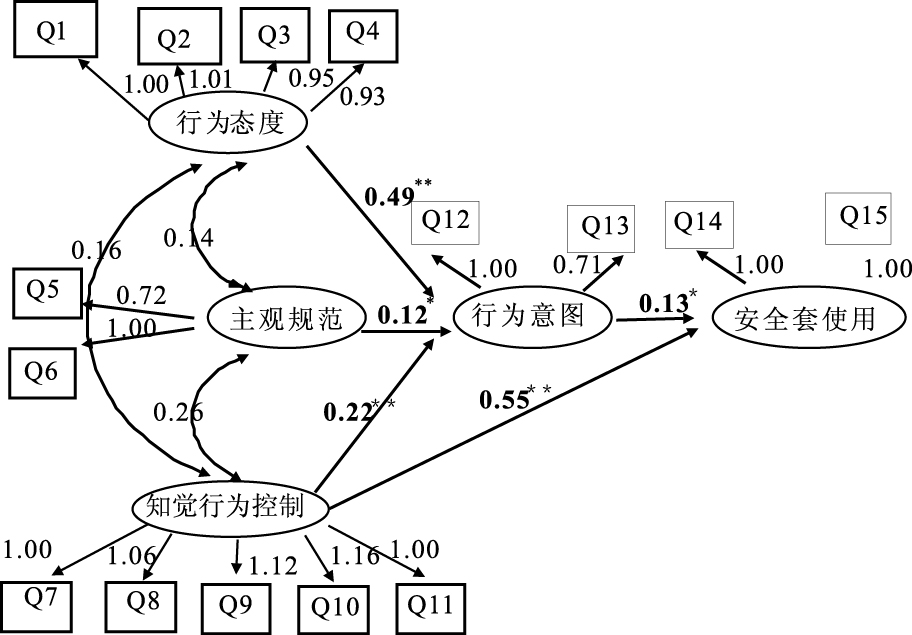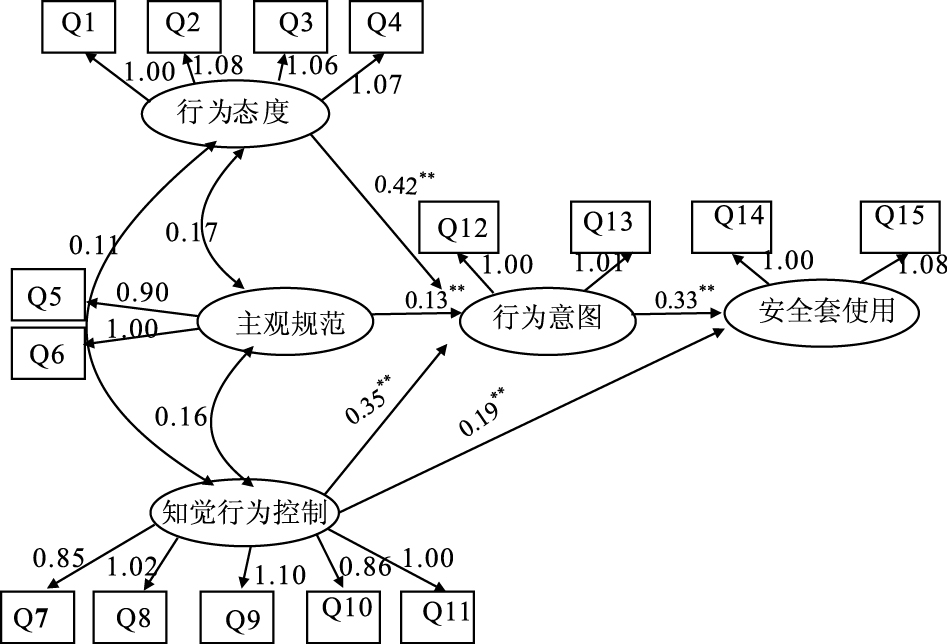Predictors related to condom use behaviors based on the theory of planned behavior among female sex workers
-
摘要:
目的 研究湖北省不同档次场所暗娼(female sex workers,FSWs)安全套使用的影响因素。 方法 基于计划行为理论(theory of planned behavior,TPB)抽查湖北省六市的816名FSWs进行问卷调查,应用结构方程模型分析不同档次场所FSWs在商业性行为中安全套使用的影响因素。 结果 低档场所FSWs最近1次和最近1月商业性行为中安全套使用率均低于中高档场所FSWs(t=5.80,P < 0.001)。不同场所FSWs的TPB评分差异有统计学意义,低档场所FSWs知觉行为控制评分(11.43±2.86)低于中高档场所FSWs(12.06±2.87)(t=3.07,P=0.002);但行为意图评分(5.47±1.11)高于中高档场所(5.20±1.15)(t=3.35,P=0.001)。知觉行为控制是低档场所FSWs使用安全套的最强影响因素(路径系数为0.55,P < 0.001),而安全套使用意图是中高档场所FSWs使用安全套的最强影响因素(路径系数为0.33,P < 0.001)。对于所有研究对象,安全套使用态度是安全套使用意图的最强影响因素(路径系数为0.49和0.42,P < 0.001)。 结论 提高FSWs对安全套的使用态度是提高FSWs安全套使用意图的重要举措。对于低档场所FSWs,应提高知觉行为控制相关因素;对于高档场所FSWs,应提高其安全套使用意愿。 Abstract:Objective To identify predictors related to condom use in different tiered female sex workers (FSWs) in Hubei Province. Methods A cross-sectional study was conducted in Hubei Province in 2015 to investigate 816 eligible FSWs by using a multistage sampling method. All data were collected by using a structured questionnaire with scales on condom use, which was designed based on the theory of planned behavior (TPB). A structural equation model (SEM) was used to identify predictors of condom use in the different tiered FSWs. Results It showed that low-tier FSWs used less condom than higher-tier FSWs in commercial sexual behaviors of the last time and during the last month(P < 0.001). The TPB scores were significantly different in different tiered FSWs. The scores of PBC in low-tier FSWs were lower than those in higher-tier FSWs (11.43±2.86 vs 12.06±2.87, respectively, P=0.002); But the scores of behavioral intentions were higher than those in higher-tier FSWs (5.47±1.11 vs 5.20±1.15, respectively, P=0.001). The PBC was the major factor related to condom use in low-tier FSWs (effect coefficient=0.55, P < 0.001), while the behavioral intention was the major factor related to condom use in higher-tier FSWs (effect coefficient=0.33, P < 0.001). Behavioral attitude was the major factor of intention to use condoms for both low-tier (effect coefficient=0.49, P < 0.001) and higher-tier FSWs (effect coefficient=0.42, P < 0.001). Conclusions Changing the attitude to condom use in FSWs is an important measure to promote the behavior intention. Condom promotion interventions should focus on the perceived behavioral control in low-tier FSWs, and promote the behavior intention in higher-tier FSWs. -
Key words:
- Female sex workers /
- Condom use /
- Structural equation model /
- Theory of planned behavior
-
性传播疾病(sexually transmitted disease,STD),简称性病,是一类主要通过性接触、类似性接触而感染的泌尿生殖道感染性疾病的总称。在性病的多种传播途径中,性行为直接传染尤为重要,其中无保护的商业性行为是传播的主要途径之一[1]。暗娼(female sex workers,FSWs)是指从事商业性行为的女性,因其高流动性、多性伴侣、性病知识缺乏等特点而成为性病的高风险人群,也是性病的重要传染源[2]。而防治性病的综合措施难以完全覆盖这一部分人群,因而FSWs人群中艾滋病、梅毒等性病的患病率均高于一般人[2-3],但是研究显示FSWs人群使用安全套的比例并不高[4],多年来防治性病的经验提示,戴安全套的性行为是控制性病的一个最安全、有效的方式[5]。计划行为理论(theory of planned behavior,TPB)是最广泛使用的探索社会和健康行为的理论之一,因其基础理论假设的一致性、良好的预测力及干预的敏感性等特点在安全套使用的影响因素研究中广泛应用[6-8]。本研究在湖北省开展FSWs人群安全套使用影响因素调查,基于行为计划理论应用结构方程模型探索不同档次FSWs人群安全套使用影响因素,以期为开展FSWs人群安全套使用干预措施提供理论依据。
1. 内容与方法
1.1 研究对象
根据湖北省武汉市以及各地州市FSWs规模将湖北省分为3个抽样层,在每一层内随机抽取若干地区作为调查点,第一阶段抽取的地区是:武汉,宜昌、襄阳、黄冈、黄石、潜江;在第二阶段,以武汉市随机抽取的3个区,宜昌、襄阳、黄冈、黄石市区和随机抽取的一个县,潜江市区和随机抽取的一个乡镇作为调查点,于2015年1-6月,抽取上述地区娱乐场所的FSWs进行问卷调查。共发放问卷860份,收回816份,有效率94.9%。所有研究对象均签署知情同意书。
1.2 研究内容
调查内容包括:(1)个人一般情况:性别、年龄、籍贯、现住址、文化程度、婚姻状况等;(2)安全套使用情况:固定性伴侣和商业性行为安全套使用情况,安全套的获得途径等;(3)自我设计的安全套使用TPB量表。其中,安全套使用TPB量表包括5个维度:行为态度、主观行为规范、知觉行为控制、行为意图和行为。各指标的测量条目主要采用Likert自评式3点量表法,计分为1~3分。各指标赋值情况见表 1。
表 1 基于TPB的安全套使用测量条目赋值Table 1. The measurement item assignment of condom use based on the theory of planned behavior项目 指标变量 赋值结果 1 2 3 行为态度 Q1 艾滋病可以通过安全套来预防 不可以 不清楚 可以 Q2 性病可以通过用安全套来预防 不可以 不清楚 可以 Q3 安全套避孕效果好 不同意 不好说 同意 Q4 不用可以省钱 同意 不清楚 不同意 主观规范 Q5 客人希望我在做生意的过程中应该使用安全套 不希望 不好说 希望 Q6 老板希望我在做生意的过程中应该使用安全套 不希望 不好说 希望 知觉行为控制 Q7 当客人提出不用安全套时,你能否说服他用 不能 不一定 能 Q8 多给钱不使用安全套,你是否会同意 会 不一定 不会 Q9 你接客的时候是否随身携带安全套 否 不一定 是 Q10 在接客的时候是否有足够的安全套使用 否 不一定 是 Q11 购买安全套花费大小 大 一般 小 行为意向 Q12 下一次接客你是否打算使用安全套 不打算 不一定 打算 Q13 下一个月你是否打算持续使用安全套 不打算 不一定 打算 行为 Q14 最近一次商业性行为是否使用安全套 否 - 是 Q15 最近一个月商业性行为是否持续使用安全套 否 有时 是 1.3 相关指标定义
FSWs场所分类(1)低档场所FSWs通常是指街头FSWs或者是在临时出租屋中从事商业性交易的FSWs,通常每次性交易价格<100元[9-10];(2)中高档场所FSWs通常是指在酒店、洗浴桑拿中心、足浴按摩、发廊、KTV、茶室等场所从事商业性交易的FSWs,通常每次性交易价格≥100元[10-11]。
1.4 统计学方法
计量资料使用(x±s)描述,计数资料描述使用频数和构成比,两组总体均数比较使用t检验,多组均数比较使用单因素方差分析,两组及多组总体率比较采用χ2检验,等级资料采用秩和检验。采用探索性因子分析验证TPB量表的结构效度。应用结构方程分别建立低档和中高档FSWs安全套使用的TPB模型。以上统计分析采用SPSS 24.0和AMOS 21.0软件完成。检验水准α=0.05。
2. 结果
2.1 调查对象人口学特征
本研究共纳入研究对象816人,其中高档场所FSWs有508人,低档场所FSWs有308人。低档场所FSWs的平均年龄高于高档场所(P < 0.001)。低档场所FSWs文化程度高于中高档场所(P < 0.001)。低档场所FSWs已婚者多于中高档场所(P < 0.001)。低档场所FSWs因维持家庭开支而从事性服务工作的比例高于中高档场所(P=0.004)。见表 2。
表 2 湖北省不同档次女性性工作者人口学特征[n(%)]Table 2. Demographic characteristics of different tiered female sex workers in Hubei Province[n(%)]低档(n=308) 中高档(n=508) χ2值 P值 年龄(岁) 17.51 < 0.001 18~ 126(40.9) 250(49.2) 30~ 108(35.1) 193(38.0) ≥40 74(24.0) 65(12.8) 文化程度 53.60 < 0.001 小学 177(57.5) 169(33.3) 初中 106(34.4) 227(44.7) 高中 23(7.5) 103(20.3) 中专 2(0.6) 9(1.8) 婚姻状况 31.31 < 0.001 未婚 129(41.9) 315(62.0) 已婚 179(58.1) 193(38.0) 支持家用 12.38 < 0.001 是 215(69.8) 216(42.5) 否 93(30.2) 292(57.5) 是否本地 0.22 0.636 是 48(15.6) 73(14.4) 否 260(84.4) 435(85.6) 从事性服务时间(月) 15.28 0.004 < 3 148(48.1) 209(41.1) 3~ 60(19.5) 79(15.6) 6~ 33(10.7) 72(14.2) 12~ 23(7.5) 78(15.4) ≥24 44(14.3) 70(13.8) 2.2 商业性行为中安全套使用情况
低档场所FSWs最近1次以及最近1月商业性行为安全套使用率均低于中高档场所(P < 0.001),中高档场所FSWs自己购买安全套者所占比例显著高于低档场所(P < 0.001)。对于“客人多给钱,是否同意无保护性行为”,中高档场所FSWs同意的比例高于低档场所(P < 0.001)。在中高档场所,FSWs能够成功劝说客人使用安全套的比例高于低档场所(P < 0.001)。见表 3。
表 3 湖北省不同档次女性性工作者安全套使用情况[n(%)]Table 3. The condom using behavior of different tiered female sex workers in Hubei Province[n(%)]低档(n=308) 中高档(n=508) χ2值 P值 最近1次商业性行为是否使用安全套 54.68 < 0.001 是 231(75.0) 474(93.3) 否 77(25.0) 34(6.7) 最近1月商业性行为是否使用安全套 54.42 < 0.001 是 185(60.1) 411(80.9) 否 123(39.9) 97(19.1) 自己购买安全套 116.45 < 0.001 是 124(40.3) 395(77.8) 否 184(59.7) 113(22.2) 当客人多给钱,是否同意无保护性行为 17.27 < 0.001 是 143(46.4) 311(61.3) 否 165(53.6) 196(38.7) 能否劝说客人使用安全套 25.56 < 0.001 是 145(31.2) 330(65.1) 否 163(68.8) 117(34.9) 2.3 安全套使用TPB量表的信度和效度分析
通过探索性因子分析识别出5个公因子,5个公因子的累计方差贡献率达到63.57。各TPB组分所含条目在其公因子上的载荷均>0.6,而在其他公因子上的载荷则小于主因子。这些结果显示本研究TPB量表效度尚可。对TPB量表中各组分所含条目的内部一致性分析显示各个TPB组分所含条目的Cronbach’s系数均>0.7。表明本研究的TPB量表具有较高的信度。
2.4 不同档次人群安全套使用的TPB各组分评分比较
不同档次的FSWs各组评分不同,其中行为态度和主观规范评分差异无统计学意义(均有P>0.05)。低档FSWs的知觉行为控制评分低于中高档(P=0.002),而行为意图评分高于中高档FSWs(P=0.001)。对于安全套使用行为评分,低档FSWs的评分低于中高档FSWs(P < 0.001)。见表 4。
表 4 低档和中高档FSWs人群TPB组分评分比较Table 4. Comparison of TPB components scores in low-tier and higher-tier FSWs组分 低档(N=308) 中高档(N=508) t值 P值 行为态度 10.38±2.17 10.49±2.07 0.72 0.469 主观规范 4.18±1.53 4.12±1.22 0.51 0.609 知觉行为控制 11.43±2.86 12.06±2.87 3.07 0.002 行为意图 5.47±1.11 5.20±1.15 3.35 0.001 安全套使用行为 5.28±0.93 5.63±0.76 5.80 < 0.001 2.5 安全套使用影响因素的结构方程模型分析
以安全套使用行为得分为因变量,构建不同场所FSWs安全套使用与行为态度、主观规范、知觉行为控制、行为意图的结构方程模型。在低档场所FSWs中,知觉行为控制对低档场所FSWs安全套使用行为的影响力最大(P < 0.001),其次是安全套使用意图(P=0.042),见图 1。对于中高档场所FSWs,行为意图对安全套使用行为的影响最强(P < 0.001),其次是知觉行为控制(P < 0.001),见图 2。对低档和中高档FSWs安全套使用意图影响最强的组分是安全套使用的态度(P < 0.001),其次是知觉行为控制(P < 0.001),最弱的是主观行为规范(P=0.054)。
3. 讨论
本研究结果显示,中高档场所FSWs最近1次及最近1月商业性行为安全套使用率均高于低档场所FSWs,TPB可较好地分析娱乐场所FSWs安全套使用行为的影响因素,知觉行为控制(perceived behavioral control, PBC)和安全套使用意图分别是低档和中高档场所FSWs在商业性行为中使用安全套的关键因素;对于所有研究对象来说,安全套使用态度是安全套使用意图的重要因素。
TPB在西方国家广泛应用于性风险行为的研究,特别是安全套的使用[4, 12-13]。2011年的一项荟萃分析[14]表明,TPB能够解释43.3%的健康行为意图差异,以及19.3%的后续健康行为差异。本研究结果表明,PBC是决定低档场所FSWs安全套使用意图的主要因素,PBC主要表现在缺乏说服客人使用安全套的技巧、为收取更高的服务费用时听从客人不使用安全套、因为安全套花销大而不愿意主动去购买以及工作场所未提供足够的安全套。根据本研究低档场所FSWs的人口学特征,低档场所FSWs年龄偏大,文化程度较低,因而缺乏性病的相关知识,缺乏劝说客人使用安全套的技巧,既往研究[15-16]提示,文化程度和安全套的使用有相关性,且低档场所FSWs已婚者偏多,他们因维持家庭开支而从事性服务的比例偏高,既往研究[17]也表明FSWs因经济困难及环境支撑等因素而无法坚持使用安全套;此外,在低档场所普遍存在嫖客拒绝使用安全套的现象[18],这就使得在低档场所,安全套的使用率相对较低。而在中高档场所,安全套使用意图是决定中高档场所FSWs安全套使用的主要影响因素,安全套使用意图的最大影响因素是对安全套使用的态度,主要表现在FSWs对性病以及安全套使用知识的掌握程度,相比于低档场所,中高档场所FSWs年龄偏低,文化程度较高,且未婚者占大多数,在性病知识、安全套使用知识掌握以及安全套使用方法等方面均优于低档场所FSWs,这可能与中高档场所客源稳定、价格较高,因此对FSWs的门槛较高有关,同时中高档场所FSWs在商业性行为时自行购买安全套的比例较高,这可能与她们自我保护的意识较强有关。有研究也表明,安全套使用态度是决定中高档场所FSWs使用安全套的主要因素[14, 19]。
既往研究[10]指出,不同场所的FSWs安全套使用的主要影响因素不同,所以应当采取有针对性的措施。根据本研究的结果提示,在今后制定FSWs人群安全套干预措施时,针对低档场所FSWs,应该提高安全套的可及性,如对其发放免费安全套,定期开展安全套使用讲座,强化其对使用安全套预防性病的认识,提高其劝说嫖客使用安全套的交流技巧。针对中高档场所FSWs,则应加强STD的危害以及安全套使用优点等相关知识的掌握,以提高其使用安全套的意图。基于以上结果,我们的研究对制定FSWs人群安全套干预措施提供了指导意义。
TPB能够很好地解释安全套使用的影响因素,在今后的FSWs安全套干预中应基于行为计划理论,对不同档次开展针对性的干预。对低档场所FSWs,应提高其知觉行为控制,如发放免费安全套;对于中高档场所FSWs,应加强其安全套使用意愿,如强化性病知识教育。
-
表 1 基于TPB的安全套使用测量条目赋值
Table 1. The measurement item assignment of condom use based on the theory of planned behavior
项目 指标变量 赋值结果 1 2 3 行为态度 Q1 艾滋病可以通过安全套来预防 不可以 不清楚 可以 Q2 性病可以通过用安全套来预防 不可以 不清楚 可以 Q3 安全套避孕效果好 不同意 不好说 同意 Q4 不用可以省钱 同意 不清楚 不同意 主观规范 Q5 客人希望我在做生意的过程中应该使用安全套 不希望 不好说 希望 Q6 老板希望我在做生意的过程中应该使用安全套 不希望 不好说 希望 知觉行为控制 Q7 当客人提出不用安全套时,你能否说服他用 不能 不一定 能 Q8 多给钱不使用安全套,你是否会同意 会 不一定 不会 Q9 你接客的时候是否随身携带安全套 否 不一定 是 Q10 在接客的时候是否有足够的安全套使用 否 不一定 是 Q11 购买安全套花费大小 大 一般 小 行为意向 Q12 下一次接客你是否打算使用安全套 不打算 不一定 打算 Q13 下一个月你是否打算持续使用安全套 不打算 不一定 打算 行为 Q14 最近一次商业性行为是否使用安全套 否 - 是 Q15 最近一个月商业性行为是否持续使用安全套 否 有时 是 表 2 湖北省不同档次女性性工作者人口学特征[n(%)]
Table 2. Demographic characteristics of different tiered female sex workers in Hubei Province[n(%)]
低档(n=308) 中高档(n=508) χ2值 P值 年龄(岁) 17.51 < 0.001 18~ 126(40.9) 250(49.2) 30~ 108(35.1) 193(38.0) ≥40 74(24.0) 65(12.8) 文化程度 53.60 < 0.001 小学 177(57.5) 169(33.3) 初中 106(34.4) 227(44.7) 高中 23(7.5) 103(20.3) 中专 2(0.6) 9(1.8) 婚姻状况 31.31 < 0.001 未婚 129(41.9) 315(62.0) 已婚 179(58.1) 193(38.0) 支持家用 12.38 < 0.001 是 215(69.8) 216(42.5) 否 93(30.2) 292(57.5) 是否本地 0.22 0.636 是 48(15.6) 73(14.4) 否 260(84.4) 435(85.6) 从事性服务时间(月) 15.28 0.004 < 3 148(48.1) 209(41.1) 3~ 60(19.5) 79(15.6) 6~ 33(10.7) 72(14.2) 12~ 23(7.5) 78(15.4) ≥24 44(14.3) 70(13.8) 表 3 湖北省不同档次女性性工作者安全套使用情况[n(%)]
Table 3. The condom using behavior of different tiered female sex workers in Hubei Province[n(%)]
低档(n=308) 中高档(n=508) χ2值 P值 最近1次商业性行为是否使用安全套 54.68 < 0.001 是 231(75.0) 474(93.3) 否 77(25.0) 34(6.7) 最近1月商业性行为是否使用安全套 54.42 < 0.001 是 185(60.1) 411(80.9) 否 123(39.9) 97(19.1) 自己购买安全套 116.45 < 0.001 是 124(40.3) 395(77.8) 否 184(59.7) 113(22.2) 当客人多给钱,是否同意无保护性行为 17.27 < 0.001 是 143(46.4) 311(61.3) 否 165(53.6) 196(38.7) 能否劝说客人使用安全套 25.56 < 0.001 是 145(31.2) 330(65.1) 否 163(68.8) 117(34.9) 表 4 低档和中高档FSWs人群TPB组分评分比较
Table 4. Comparison of TPB components scores in low-tier and higher-tier FSWs
组分 低档(N=308) 中高档(N=508) t值 P值 行为态度 10.38±2.17 10.49±2.07 0.72 0.469 主观规范 4.18±1.53 4.12±1.22 0.51 0.609 知觉行为控制 11.43±2.86 12.06±2.87 3.07 0.002 行为意图 5.47±1.11 5.20±1.15 3.35 0.001 安全套使用行为 5.28±0.93 5.63±0.76 5.80 < 0.001 -
[1] Yang X, Li S, Attane I, et al. Commercial sex behaviours among involuntary male bachelors: findings from a survey of migrants in Xian, China[J]. J Public Health (Oxf), 2015, 37(2): 305-312. DOI: 10.1093/pubmed/fdu047. [2] Guo Y, Xu X, Fu G, et al. Risk behaviours and prevalences of HIV and sexually transmitted infections among female sex workers in various venues in Changzhou, China[J]. Int J STD AIDS, 2017, 28(11): 1135-1142. DOI: 10.1177/0956462416689763. [3] Halatoko WA, Landoh DE, Saka B, et al. Prevalence of syphilis among female sex workers and their clients in Togo in 2011[J]. BMC Public Health, 2017, 17(1): 219. DOI: 10.1186/s12889-017-4134-x. [4] Zhang L, Shah IH, Li X, et al. Does the use of HIV testing and counseling services influence condom use among low-paid female sex workers in Guangxi, China[J] AIDS Care, 2017, 29(3): 335-338. DOI: 10.1080/09540121.2016.1220482. [5] Sadler S, Tosh J, Pennington R, et al. A cost-effectiveness analysis of condom distribution programmes for the prevention of sexually transmitted infections in England[J]. J Epidemiol Community Health, 2017, 71(9): 897-904. DOI: 10.1136/jech-2017-209020. [6] Moeini B, Barati M, Hazavehei SMM, et al. Applying theory of planned behavior to predict condom use intention among Iranian substance users covered by addiction treatment centers[J]. J Subst Use, 2017, 22(5): 511-515. DOI: 10.1080/14659891.2016.1259363. [7] Andrew BJ, Mullan BA, de Wit JB, et al. Does the theory of planned behaviour explain condom use behaviour among men who have sex with men? a meta-analytic review of the literature[J]. AIDS Behav, 2016, 20(12): 2834-2844. DOI: 10.1007/s10461-016-1314-0. [8] Turchik JA, Gidycz CA. Exploring the intention-behavior relationship in the prediction of sexual risk behaviors: can it be strengthened[J] J Sex Res, 2012, 49(1): 50-60. DOI: 10.1080/00224499.2011.578220. [9] 方艳姣, 豆正东, 杨康生等. 2013-2015年芜湖市FSWs人群艾滋病哨点监测结果[J]. 职业与健康, 2018, 34(3): 374-378. DOI: 10.13329/j.cnki.zyyjk.2018.0107Fang YJ, Dou ZD, Yang KS, et al. Results of sentinel surveillance of HIV/AIDS among sex workers in Wuhu City from 2013-2015[J]. Occup and Health, 2018, 34(3): 374-378. DOI: 10.13329/j.cnki.zyyjk.2018.0107 [10] Chen B, Chen J, Shao Y, et al. Need for intervention services for promotion of condom use by female sex workers to consider size of entertainment venues: a cross-sectional study[J]. Med Sci Monit Basic Res, 2019, 25: 1-7. DOI: 10.12659/MSMBR.913161. [11] 吴忠恕, 王剑, 豆正东, 等. 芜湖市FSWs人群安全套使用情况及其影响因素[J]. 中国艾滋病性病, 2015, 21(10): 871-874. DOI: 10.13419/j.cnki.aids.2015.10.13.Wu ZS, Wang J, Dou ZD, et al. Study on condom using among female sex workers and its influencing factors in Wuhu City[J]. Chin J AIDS STD, 2015, 21(10): 871-874. DOI: 10.13419/j.cnki.aids.2015.10.13. [12] Guan M, Coles VB, Samp JA, et al. Incorporating communication into the theory of planned behavior to predict condom use among African American women[J]. J Health Commun, 2016, 21(9): 1046-1054. DOI: 10.1080/10810730.2016.1204383. [13] Ramirez-Correa P, Ramirez-Santana M. Predicting condom use among undergraduate students based on the theory of planned behaviour, Coquimbo, Chile, 2016[J]. Int J Environ Res Public Health, 2018, 15(8): 1689. DOI: 10.3390/ijerph15081689. [14] Ajzen I. The theory of planned behaviour: reactions and reflections[J]. Psychol Health, 2011, 26(9): 1113-1127. DOI: 10.1080/08870446.2011.613995. [15] Liu H. Egocentric network and condom use among mid-age female sex workers in China: a multilevel modeling analysis[J]. AIDS Patient Care STDS, 2016, 30(4): 155-165. DOI: 10.1089/apc.2015.0349. [16] Chingle MP, Odunze PA, Mohammed A, et al. Predictors of male condom utilization in Plateau State, Nigeria[J]. Niger J Clin Pract, 2017, 20(9): 1079-1087. DOI: 10.4103/njcp.njcp_56_17. [17] Hodder RK, Homer S, Freund M, et al. The association between adolescent condom use and individual and environmental resilience protective factors[J]. Aust N Z J Public Health, 2018, 42(3): 230-233. DOI: 10.1111/1753-6405.12744. [18] Yang Y, Yang C, Latkin CA, et al. Condom use during commercial sex among male clients of female sex workers in Sichuan China: a social cognitive theory analysis[J]. AIDS Behav, 2016, 20(10): 2309-2317. DOI: 10.1007/s10461-015-1239-z. [19] Protogerou C, Flisher AJ, Wild LG, et al. Predictors of condom use in South African university students: a prospective application of the theory of planned behavior[J]. J Appl Soc Psychol, 2013, 43(S1): E23-E36. DOI: 10.1111/jasp.12039. 期刊类型引用(0)
其他类型引用(1)
-





 下载:
下载:



 下载:
下载:



